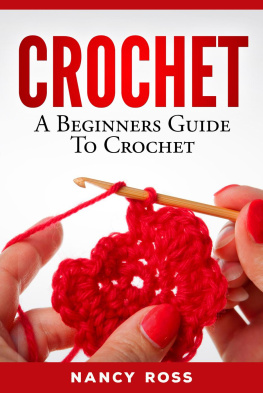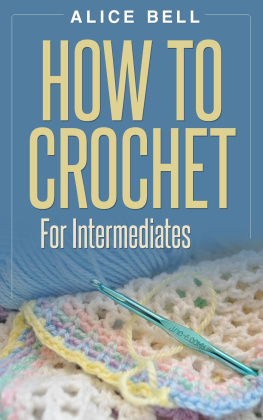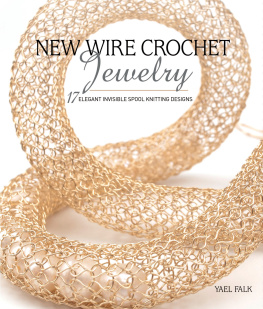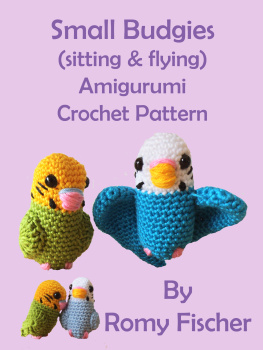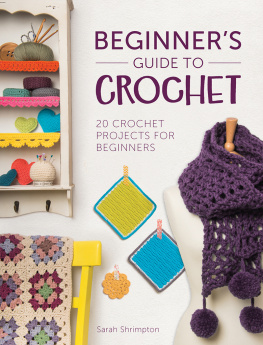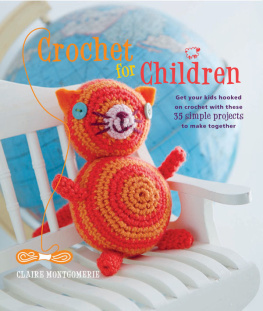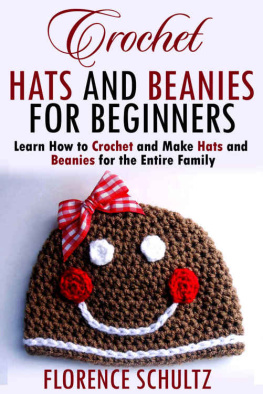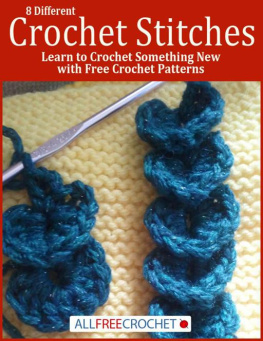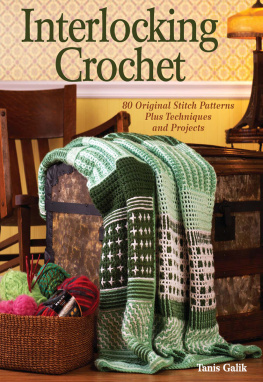CROCHET
BY
EUNICE CLOSE
CONTENTS
PREFACE
DURING the last few years there has occurred one of those revivals of fashion which has once more brought crochet to the fore. Unfortunately a great many people have never actually learned how to crochet and, although they would like to be able to make all kinds of things in this fascinating craft, they are at a loss when they come to start. Others, again, may know one or two basic stitches but hesitate to attempt what they feel to be intricate designs because they feel sure that their limited knowledge is insufficient to enable them to follow the directions properly.
It is for these two kinds of people that this book has been written. In addition to a clear explanation of how to work the actual stitches and a concise classification of the various groups of stitches and types of crochet the reader will find an explanation of all the technical terms and abbreviations used in crochet and full directions for making a number of attractive and useful articles; and I shall try to show that, although some of the examples of crochet lace you see may bear comparison with the most elaborate specimens to be found in museums, they are not beyond the capabilities of the worker who is able to follow directions and to execute the few and simple stitches that form the foundation of all crochet.
E.C.
CHAPTER I
Crochet as a craft. Its origin and history. Materials and their suitability for various purposes. Tools.
THERE appears to be some doubt as to the origin of the craft of crochet for the amount of information to be obtained on the subject of its history is very scanty. Two theories present themselves as throwing some light on the subject. At one time, as we know from records and pictures, knitting was worked, not with pointed needles but with hooked ones. It is possible, therefore, that crochet was developed from this form of knitting, and that, when the pointed needles gradually ousted the hooked ones, work with the latter type developed independently along its own lines, and became crochet as we know it today.
The second theory suggests that crochet developed through lace-making. A hook wasand, indeed, still isused in several types of lace-making, notably pillow-lace and tatting, and gradually a great many stitches were evolved which required nothing but a hook and a ball of thread for their execution.
Whichever theory is the correct one we must admit that crochet, as a craft, deserves the popularity it has attained, if only for the simplicity of the tools required and the ease with which proficiency may be acquired by anyone willing to take the trouble to learn the few basic stitches.
Incidentally, the name crochet is derived from the French word croche, which means a hook, so that the term crochet-work simply means something constructed with the aid of a hook; or, if it is used as a verb, an action which one performs with a hook.
At first crochet was almost solely confined to convents and was one of the crafts which went under the general name of nuns work. This probably explains why so many ecclesiastical vestments and hangings were, and still are, decorated with crochet lace.
About the middle of the 19th century, when the Irish Famine caused so much hardship, the abbess of a convent in Ireland conceived the idea of teaching her pupils to make crochet lace which could be sold in order to help to mitigate the dreadful conditions under which many of them lived. Irish crochet, which has a character all its own, was developed as an imitation of Venetian point lace although, of course, the difference in the method of working naturally affected the result. The nuns attempts at developing the art of crochet were successful and so fashionable did crochet become that soon no young lady was considered to be properly educated unless she could crochet.
Since the middle of the last century the popularity of crochet as a craft has fluctuated considerably. During the recent war, when materials for other crafts were scarce and time was limited, crochet was taken up by many people who found that materialsof a sortwere plentiful and that crochet was one of those crafts which required little space for its execution and which could be pursued at odd moments.
In the years immediately following the war many designers put out books and leaflets containing new and attractive designs in tune with modern ideas and the great majority of these are so carefully worked out and tested that the worker need have no fear that she will be unable to follow them or that the directions will not be clear and easy to follow. Threads of all kinds are once more available in profusion and you should have no difficulty in obtaining just the material and shade you need. Although in common with everything else, crochet threads are more expensive than they used to be, crochet is still one of the cheapest forms of craft work I know and the cost of the handmade article is ridiculously cheap when compared with a similar article bought from a shop.
Lace made from crochet may be found in museums in many parts of the world and the method of working and the types of patterns seem to vary little from place to place. Quite a flourishing industry exists for the making of crochet gloves and these have been extremely fashionable during the last few years, since they are reasonable in price, attractive to look at and cool to wear. They are quite simple to make and a pair in crochet cotton will cost you only a few shillings and a few hours pleasant work.
Crochet work is used in a great many ways, but particularly for the adornment of the home. Duchesse and lunch sets, chair backs, runners, tablecloths and even bedspreads can be made entirely of crochet, while lace borders add to the attractiveness of such things as traycloths, pillowslips, towels and handkerchiefs.
Crochet can be used, too, for rugs and other useful household articles, both large and small. I am not very fond of crochet when it is used for jumpers and so on except when a particularly firm fabric in wool or a lacy one in cotton is required. Crochet is not so elastic as knitting and the fabric made from it is thicker; at the same time crochet can be used very successfully in conjunction with knitting as a means of decorating the edges or of strengthening the borders and regulating the size of a piece of knitted fabric.
Materials
When we begin to consider the materials from which we intend to make crochet lace we are confronted with a bewildering array from which to choose. First, of course, comes the thread known as Crochet cotton. As its name implies this is a cotton thread made especially for the purpose. It is strong, very firmly and evenly twisted and it usually wears very well indeed. The mercerized variety which is very popular among crochet workers has a silky finish which adds much to the attractiveness of the finished work.
Most crochet cottons can be obtained in white, ecru and in many attractive colours. The thickness varies from quite a coarse onesay number 3to a really fine one, which is thinner than ordinary sewing sylko and which is labelled number 100. The different makes vary a little in the thickness of the numbers, although all of them start with the low numbers for the thickest, going up to the high numbers for the finest threads. The coloured threads are usually a little more expensive than the white or ecru ones.
Linen and flax threads, such as those used in lace-making can also be used for crochet and they wash and wear extremely well.
Next we have threads of the Sylko variety and these are useful for such things as gloves and belts. They, too, can be obtained in many colours although there are only about three different thicknesses. Rayon threads are often used for crochet work, particularly for such things as duchesse sets, although I find that some of them are rather limp and, when used on a polished table, apt to slip about. Great care must be used in choosing rayon threads for crochet since a thread that is too loosely woven may catch in the hook and become split and frayed. Cheap thread should never be used for it will always prove to be dearest in the end. Dish cloth cotton can also be used for crochet and indeed, if you are learning to crochet it is an excellent material upon which to practise your stitches.


